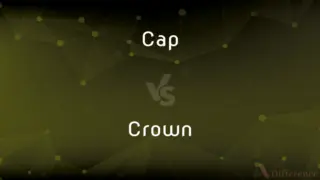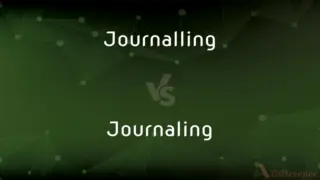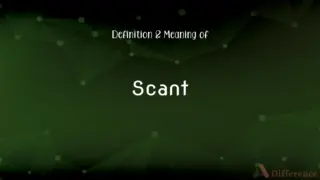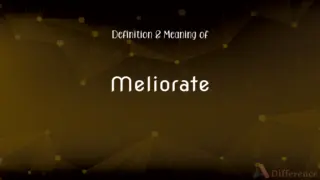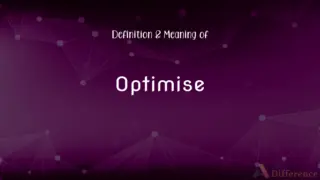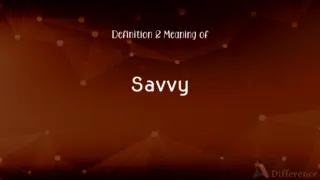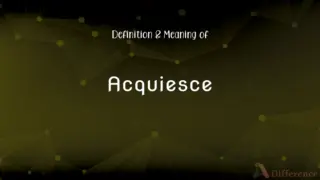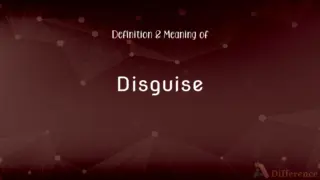Enigma vs. Stigma — What's the Difference?
By Maham Liaqat & Urooj Arif — Updated on April 19, 2024
An enigma involves mystery and puzzlement, often intriguing; stigma refers to a mark of disgrace or social disapproval, carrying negative connotations.

Difference Between Enigma and Stigma
Table of Contents
ADVERTISEMENT
Key Differences
An enigma is something that is mysterious, puzzling, or difficult to understand, often capturing curiosity and fascination. Whereas, a stigma is a mark or perception of disgrace associated with a particular circumstance, quality, or person, typically causing exclusion or discrimination.
Enigmas can be intellectual challenges that stimulate discussion and analysis, like a cryptic puzzle or an ambiguous story. On the other hand, stigma often leads to negative social outcomes, such as isolation or prejudice, stemming from misconceptions or societal norms.
The concept of enigma does not carry inherent negative connotations; it is often seen positively in contexts that value mystery and intellectual challenge. Conversely, stigma is inherently negative, impacting individuals' mental health and social standing.
Enigmas are universal and can be encountered in various cultures and fields, ranging from literature to science. In contrast, stigmas can vary widely between different societies and cultural settings, depending on prevailing social attitudes and beliefs.
While enigmas invite exploration and resolution, bringing a sense of satisfaction or enlightenment, stigmas involve managing and overcoming societal judgment, which can be a source of significant personal struggle.
ADVERTISEMENT
Comparison Chart
Connotation
Intriguing, mysterious
Disgraceful, discriminating
Social Impact
Stimulates curiosity and debate
Causes exclusion and discrimination
Emotional Impact
Can be intellectually stimulating
Often leads to shame and distress
Variability
Universal across cultures
Varies with cultural and social norms
Outcome
Resolution brings satisfaction
Overcoming involves personal struggle
Compare with Definitions
Enigma
Often used to describe complex puzzles or riddles.
The ancient script was an enigma to archaeologists.
Stigma
A mark of disgrace associated with a particular circumstance.
There is a significant stigma attached to mental health issues.
Enigma
A person or thing that is mysterious or difficult to understand.
The silent movie star remains an enigma decades later.
Stigma
Can be attached to illnesses, behaviors, or identities.
HIV/AIDS carries a strong social stigma.
Enigma
Something that baffles understanding and cannot be explained.
How he achieved the feat remains an enigma.
Stigma
Efforts to combat stigma focus on education and awareness.
Campaigns aim to reduce the stigma around addiction.
Enigma
Can relate to mysterious characters in literature.
The detective in the novel is an enigma wrapped in a mystery.
Stigma
Social stigma involves negative stereotypes or discrimination.
The stigma of poverty can affect children's self-esteem.
Enigma
Represents the unknown elements of scenarios.
The motive behind the action was an enigma to all.
Stigma
Often internalized by those who feel judged or marginalized.
She struggled with the stigma of being unemployed.
Enigma
One that is puzzling, ambiguous, or inexplicable.
Stigma
An association of disgrace or public disapproval with something, such as an action or condition
"Depression ... has become easier to diagnose, and seeking treatment does not carry the stigma it once did" (Greg Critser).
Enigma
A perplexing speech or text; a riddle.
Stigma
A visible indicator of disease.
Enigma
Something or someone puzzling, mysterious or inexplicable.
Stigma
A small bodily mark, especially a birthmark or scar, that is congenital or indicative of a condition or disease.
Enigma
A riddle, or a difficult problem.
Stigma
(Psychology) A bleeding spot on the skin considered to be a manifestation of conversion disorder.
Enigma
Riddles and puzzles, collectively.
Stigma
Stigmata(Christianity) Bodily marks, sores, or sensations of pain corresponding in location to the crucifixion wounds of Jesus, believed to be given as divine recognition of devotion.
Enigma
Mysteriousness; obscurity; lack of clarity.
Stigma
(Botany) The apex of the pistil of a flower, on which pollen grains are deposited and germinate.
Enigma
A style of literature characterized by obscurity and hints of transcendental meaning.
Stigma
(Biology) A small mark, spot, or pore, such as the respiratory spiracle of an insect or an eyespot in certain protists.
Enigma
A protein with three LIM domains (a conserved cysteine- and histidine-rich structure of two adjacent zinc fingers) at the C terminus that regulates protein phosphorylation.
Stigma
(Archaic) A mark burned into the skin as a visible identifier of a person as a criminal or slave; a brand.
Enigma
The Talaud kingfisher, Todiramphus enigma.
Stigma
A mark of infamy or disgrace.
Enigma
A species of grasshopper, Oedaleonotus enigma.
Stigma
A scar or birthmark.
Enigma
A rare species of moth, Heliothis enigma.
Stigma
A mark on the body corresponding to one of the wounds of the Crucifixion on Jesus' body, and sometimes reported to bleed periodically.
Enigma
A dark, obscure, or inexplicable saying; a riddle; a statement, the hidden meaning of which is to be discovered or guessed.
A custom was among the ancients of proposing an enigma at festivals.
Stigma
An outward sign; an indication.
Enigma
An action, mode of action, or thing, which cannot be satisfactorily explained; a puzzle; as, his conduct is an enigma.
Stigma
(botany) The sticky part of a flower that receives pollen during pollination.
Enigma
Something that baffles understanding and cannot be explained;
How it got out is a mystery
It remains one of nature's secrets
Stigma
(medicine) A visible sign or characteristic of a disease.
Enigma
A difficult problem
Stigma
(typography) A ligature of the Greek letters sigma and tau, (Ϛ/ϛ).
Stigma
A mark made with a burning iron; a brand.
Stigma
Any mark of infamy or disgrace; sign of moral blemish; stain or reproach caused by dishonorable conduct; reproachful characterization.
The blackest stigma that can be fastened upon him.
All such slaughters were from thence called Bartelmies, simply in a perpetual stigma of that butchery.
Stigma
That part of a pistil which has no epidermis, and is fitted to receive the pollen. It is usually the terminal portion, and is commonly somewhat glutinous or viscid. See Illust. of Stamen and of Flower.
Stigma
A small spot, mark, scar, or a minute hole; - applied especially to a spot on the outer surface of a Graafian follicle, and to spots of intercellular substance in scaly epithelium, or to minute holes in such spots.
Stigma
One of the external openings of the tracheæ of insects, myriapods, and other arthropods; a spiracle.
Stigma
A point so connected by any law whatever with another point, called an index, that as the index moves in any manner in a plane the first point or stigma moves in a determinate way in the same plane.
Stigma
Marks believed to have been supernaturally impressed upon the bodies of certain persons in imitation of the wounds on the crucified body of Christ. See def. 5, above.
Stigma
The apical end of the style where deposited pollen enters the pistil
Stigma
A symbol of disgrace or infamy;
And the Lord set a mark upon Cain
Stigma
An external tracheal aperture in a terrestrial arthropod
Stigma
A skin lesion that is a diagnostic sign of some disease
Common Curiosities
What are common sources of stigma?
Common sources include mental illness, disease, and deviations from social norms.
What can be done to reduce stigma?
Reducing stigma involves educating the public, fostering empathy, and challenging misconceptions.
What is an enigma?
An enigma is something or someone that is mysterious, puzzling, or difficult to understand.
How are enigmas used in literature?
In literature, enigmas are used to create suspense and engage readers in solving mysteries.
How does stigma affect individuals?
Stigma can lead to discrimination, exclusion, and emotional distress for affected individuals.
How do societies address stigma?
Societies often address stigma through education, awareness campaigns, and promoting inclusivity.
Can an enigma be positive?
Yes, enigmas can be seen positively, especially in contexts that value mystery and intellectual challenge.
What makes something an enigma?
Being mysterious, puzzling, or inexplicable makes something an enigma.
How do enigmas and mysteries differ?
Enigmas are a type of mystery, particularly those that are especially perplexing or obscure.
Are stigmas the same worldwide?
No, what is stigmatized can vary greatly between different cultures and societies.
What is the impact of stigma on mental health?
Stigma can worsen mental health issues by causing feelings of shame and isolation.
Share Your Discovery

Previous Comparison
Grandeur vs. Grandness
Next Comparison
Endometrium vs. MyometriumAuthor Spotlight
Written by
Maham LiaqatCo-written by
Urooj ArifUrooj is a skilled content writer at Ask Difference, known for her exceptional ability to simplify complex topics into engaging and informative content. With a passion for research and a flair for clear, concise writing, she consistently delivers articles that resonate with our diverse audience.















